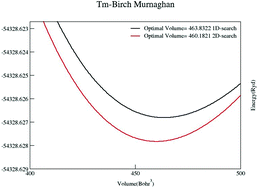Mechanical and thermodynamical properties of hexagonal compounds at optimized lattice parameters from two-dimensional search of the equation of state
Abstract
We have calculated the mechanical and thermodynamical properties of selected hexagonal structures by using the optimized lattice parameters (a and c) from two-dimensional (2D) search of the equation of state (EOS) within the appropriate exchange–correlation functional. To overcome the deficiency of density functional theory (DFT) for compounds with localized electrons, a PBE + U approximation was used with our calculated effective U parameter. For calculating the elastic constants of hexagonal structure, the Hex-elastic package was used which is compatible with the highly accurate all electron full-potential (Linearized) augmented plane-wave plus local orbital [FP-(L)APW + lo] method as implemented in the WIEN2k code. The obtained results of the 2D-search of the EOS for the optimized lattice parameters (a and c) are in good agreement with the experimental data. This method clearly shows its superiority compared to the 1D-search of the EOS method. Furthermore, the obtained elastic constants by using the optimized lattice parameters (a and c) from the 2D-search, were in good agreement with the available experimental data and better than the previous theoretical calculations. Our calculations show that the PBE + U approximation improves the results for elastic constants. Consequently, we can claim the following predictions; first, we suggest the value of Poisson's ratio as a boundary condition to predict the type of bonds. Second, we make a one-to-one correspondence between two quantities, shear modulus and C55. Third, we predict the stiffness of the material from the Debye temperature and average sound velocity.


 Please wait while we load your content...
Please wait while we load your content...